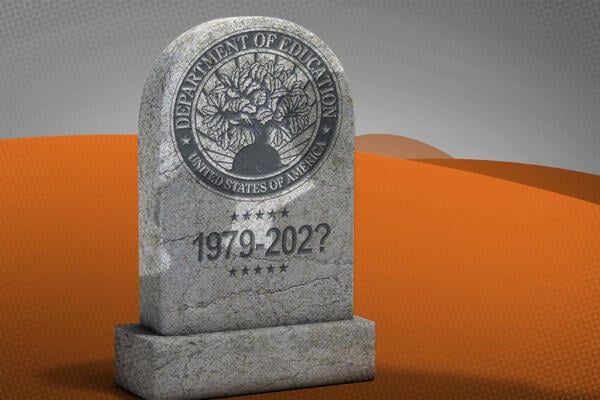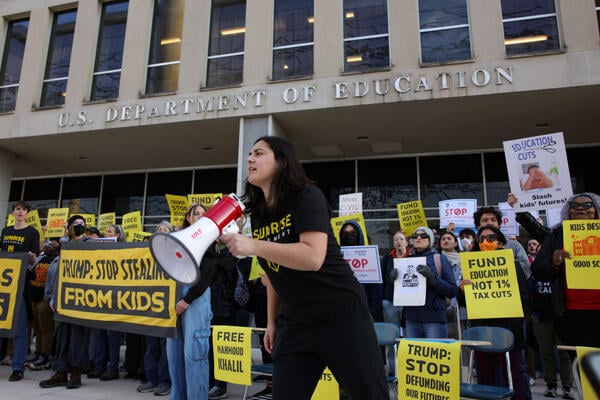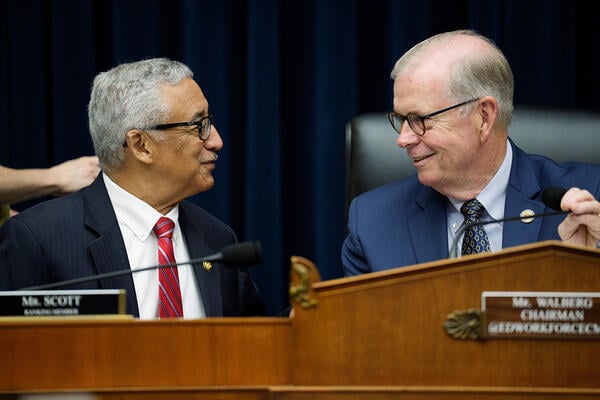
Under McMahon, ED Is Diminished but Not Dead, Experts Say
Nine months into President Donald Trump’s second term in office, he and his education secretary Linda McMahon have essentially gutted the 45-year-old Department of Education as they work toward their “final mission” of shutting it down.
First, they cut millions in grants and terminated hundreds of contracts. Then, they eliminated nearly 2,000 employees via buyouts and layoffs, slashing the department’s staff from just over 4,000 to about 2,400. With some offices erased entirely and others just a skeleton of what they once were, the administration started to ship certain grant programs and oversight responsibilities to other agencies entirely.
All the while, some colleges started to experience funding delays, financial aid officers said no one was on the line to answer their questions and students said their civil rights complaints weren’t being processed. (Distribution of Pell Grants and federal student loans has remained largely unaffected.) Trump officials have also continued to use the agency as part of its pressure campaign on higher ed.
These events, combined with the department’s latest attempt to fire another 500 employees in October, have shown how a determined executive branch can dismantle ED without congressional approval and fueled concerns about the agency’s ultimate demise. Republicans in Congress who have repeatedly stressed that only the legislative branch can shut down the department have remained largely silent.
Still, of the more than a dozen higher ed experts, politicians and former department staffers Inside Higher Ed spoke with, few were willing to pronounce the department dead. Some say that the federal government should reduce its role in education and that there was fat that needed to be trimmed at the department. But others said that even if the agency is nearing a flat line, they think it could be resuscitated.
Either way, many admitted the department is in critical condition.
“The way that I’ve been thinking about this is if you take the major organs out of a human, do you still have a human or do you have a corpse?” said Jason Cottrell, who worked in the Office of Postsecondary Education for nearly 10 years before he was fired in March. “They’ve removed the data folks and the core regulatory required entities. They’re moving offices and oversight capabilities over to other areas within the government … It’s effectively dead to me.”
Cottrell and others added that even if Democrats were to win control of Congress via the midterm elections in 2026 or take back the White House in 2028 and revitalize the department, much of the damage would already be done.
“You have to remember that the students from kindergarten all the way through graduate school are being impacted by these decisions,” he said.
Many of the programs ED runs are about improving access and equity, and if students lack those resources, it may lead to them dropping out.
“If we have to deal with this for the next four years, that’s going to be devastating,” he added, “in terms of the number of graduates from postsecondary institutions and then the impact on graduate programs and the long-term effects on our economy that has relied for so long on knowledge creation and dissemination.”

President Donald Trump signed an executive order in March directing Education Secretary Linda McMahon to shut down the Department of Education “to the maximum extent appropriate and permitted by law.”
Chen Mengtong/China News Service/VCG via Getty Images
Is ED Meeting Its Obligations?
Much of the debate over the death of the department has revolved around whether it will be able to fulfill its core statutory functions moving forward. And while Democrats and most of the higher education policy experts Inside Higher Ed spoke with were skeptical, McMahon and other Trump appointees have stressed that these duties have been met and even exceeded despite the current government shutdown, which began Oct. 1.
The Free Application for Federal Student Aid launched ahead of schedule. A regulatory committee is midway through drafting new policies to implement Congress’s sweeping higher ed overhaul. And a new rule increasing oversight on who has access to Public Service Loan Forgiveness was finalized late last week.
“Two weeks in, millions of American students are still going to school, teachers are getting paid, and schools are operating as normal,” the secretary wrote on social media last month. “It confirms what the President has said: the federal Department of Education is unnecessary, and we should return education to the states.”
Ninety-five percent of the department’s employees who don’t work on federal student aid have been furloughed.
One current department staffer, who spoke on condition of anonymity, said the question of whether the Trump administration has dismantled ED largely comes down to outcomes. And so far, at least from his perspective, most of the agency’s responsibilities have been met and grants have been distributed.
“Congress didn’t pass a law saying you shall have X number of people who work on TRIO and GEAR UP. Congress passed a law saying X billions of dollars should go to support college-access programs,” the staffer said. “And so, without being naïve about it, I think that if the department continues to say we’re running this program, we’re just doing it more efficiently, then that’s just a staffing choice. Maybe it’s a riskier one, but that feels different than dismantling.”
At the same time, the staffer acknowledged that some parts of ED are feeling the brunt of the cuts and facing significant changes as a result.
“While I don’t see outcomes changing on how state and local education agencies get their money, I think civil rights feels pretty different—that feels like a place where a pretty core function may be changing,” they said.
Not Dead, but Diminished
But to former education secretary John King Jr., who served during the Obama administration, there’s no question that President Trump and Secretary McMahon have done “extraordinary damage” to the department and its ability to carry out its duties in a way that is consistent with the intents of Congress since it was created in 1979.
King, who now serves as chancellor of the State University of New York, pointed to how the recent layoffs decimated both the Offices of Elementary and Special Education. (A federal judge paused that reduction in force last week, though many are skeptical that the injunction will hold in higher courts.)
“By decimating the staff, they limited the ability to protect the rights of students with disabilities to their services and made it harder to ensure that Title I grant dollars are getting to the most vulnerable students,” he said. (Title I is a federal formula that allocates taxpayer funding to K–12 schools in low-income communities in an effort to level out inequities in property tax.)
Many employees in the department’s Office of Postsecondary Education who help administer grants and provide support to institutions were also cut in the latest round of layoffs. But OPE’s division of Policy, Planning and Innovation, which handles the implementation of statute, is still largely intact along with the Office of Federal Student Aid, which manages the Pell Grant program and student loans.
Even if higher education institutions are not as immediately affected as K–12 schools, King said, the consequences could cascade.
“Our faculty already see that in incoming students who are less prepared [compared to students before the COVID pandemic]. And in the absence of national leadership to try to improve educational outcomes, we’re likely to see that problem worsen,” he said.
Margaret Spellings, who served as education secretary under President George W. Bush and now leads the Bipartisan Policy Committee, echoed King’s comments.
“Too many students today aren’t able to read at grade level or do basic math, and the gaps between highest- and lowest-achieving students are growing. That’s not just an education crisis. It’s an economic emergency,” she said. “That must be our urgent focus.”

Staffing cuts at the Education Department have prompted numerous protests as advocates worry about the agency’s future.
Bryan Dozier/Middle East Images/AFP via Getty Images
One source added that even though FSA still stands, it saw major cuts in March—the impact of which may not become apparent for months, until financial aid offers are back in full swing for prospective students.
Beyond the cuts, the department is looking at ways to move grant programs and other responsibilities to other agencies. The Justice Department has increased its role in investigating civil rights violations in education, and the Labor Department is set to take over career and technical education under an agreement signed in May. More recently, media outlets reported that the department was exploring moving the special education program to another agency.
Antoinette Flores, a former department appointee who now directs higher education accountability at New America, a left-leaning think tank, worries that the public won’t see the consequences of the ED cuts until it’s too late.
For example, the number of colleges that the department is tracking for financial health through a process known as heightened cash monitoring has fallen by 50 percent, Flores said. This means that the department isn’t keeping an eye on some of the riskiest institutions, and if they close, the students they serve might not have the time or resources they need to transfer.
“Sure, they’re still getting money out the door, but without all of the pieces that should go along with that,” she said. “And while that’s not something the public sees, they’re going to see it when something goes horribly wrong and it’s too late.”
Congress Should Have Final Say
Historically, when a president’s actions raised concerns about executive overreach, Congress has used its role in the constitutional system of checks and balances to hold hearings and conduct investigations, regardless of which party was in power, said Fred Lawrence, a higher ed legal expert and CEO of the Phi Beta Kappa Society. But this year, he said, lawmakers have been “surprisingly lackluster” in defending their own prerogatives.
So while legally the department can’t be shuttered without congressional say-so, Lawrence agreed with others that the Trump administration has found a number of ways to essentially undermine the agency, causing “a death by a thousand cuts.”
Rep. Tim Walberg and a spokesperson for Sen. Bill Cassidy, the Republicans who run the education committees in their chambers, suggested in statements to Inside Higher Ed that they haven’t yet sensed a need to exercise checks and balances.
Walberg said it was time to “try something new” and that he trusted McMahon when she said she would follow the law. And Cassidy’s spokesperson declined to directly answer the question, saying President Trump and Secretary McMahon are committed to returning power to the states.

Chairman Rep. Tim Walberg and Ranking Member Rep. Bobby Scott speak during a hearing.
Andrew Harnik/Getty Images
High-ranking Democrats, however, described the Trump administration’s actions as “relentless” and “illegal” and said that it will take major pushback to defend the department.
“We need everyone—but particularly Republicans in Congress—to speak out and work to stop what Trump and McMahon are doing,” said Sen. Patty Murray, who serves as ranking member of the Appropriations Committee. “The American people deserve a Department of Education that, among so much else, protects students from predatory lenders, ensures kids with disabilities can get the good education they are entitled to under law, and that actually helps students and families get ahead.”
Rep. Bobby Scott, who serves with Walberg as ranking member of Education and Workforce, added that just because Republicans are not fulfilling their oversight responsibilities, it doesn’t mean the responsibilities aren’t still there.
“The law is still the law,” Scott said.
Moving forward, multiple sources said they’re trying to find hope amid the wreckage and have looked to the estimated 2,000 civil servants working at the department each day. Rachel Gittleman, president of the union chapter that represents them, said the employees that remain are working hard to execute whatever departmental responsibilities they can.
“The department is operating with duct tape, holding it together … But we are also putting up a hell of a fight to keep it going and keep it moving,” she said. “Our union, specifically, is going to do everything that it can to make sure that there’s an ED standing at the end of this. It’s too important to the American people.”
Source link



